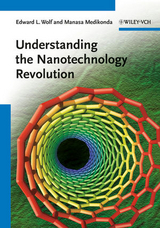Understanding the Nanotechnology Revolution
Wiley-VCH (Verlag)
978-3-527-41109-2 (ISBN)
- Titel leider nicht mehr lieferbar
- Artikel merken
The material is presented in the simplest possible way, including a few mathematical equations, but not mathematical derivations. It also outlines as simply as possible the major contributions to modern technology of physics-based nanophysical devices, such as the atomic clock, global positioning systems, and magnetic resonance imaging. As a result, readers are able to establish a connection between nanotechnology and day-to-day applications, as well as with advances in information technology based on fast computers, the internet, dense data storage, Google searches, and new concepts for renewable energy harvesting.
Also of interest to professionals working in law, finance, or teaching who wish to understand nanotechnology in a broad context, and as general reading for electrical, chemical and computer engineers, materials scientists, applied physicists and mathematicians, as well as for students of these disciplines. Einzigartiger Überblick über das Fachgebiet der Nanotechnologie für interessierte Laien. Seine eher allgemeine Ausrichtung macht dieses prägnante Sachbuch überaus interessant. Den Autoren gelingt es, die Schlüsselkonzepte verständlich und nahezu ohne Mathematik zu vermitteln.
Edward Wolf is Professor of Physics at the Polytechnic Institute of NYU, with teaching experience in modern physics, solid state physics, thermodynamics, quantum mechanics, and elementary physics. He has designed graduate courses on Nanoelectronics, Alternative Energy, and Nanotechnology on different levels. Ed Wolf is author of successful textbooks which have appeared in several editions, a audio lecture course on Nanotechnology, and a monograph on Electron Tunneling Spectroscopy. Professor Wolf has conducted research in solid state physics, scanning tunneling microscopy, electron tunneling spectroscopy and superconductivity, and published over 100 refereed publications. He is Fellow of American Physical Society, and has served as Academic Department Head and Program Director at National Science Foundation. Manasa Medikonda holds an awarded Bachelor of Engineering in Electronics and Communication Engineering from the Institute of Technology at Bangalore, India; and a Master of Science in Electrical Engineering at Polytechnic Institute of New York University. She has worked as a Software Engineer with Infosys Technologies in India, and presently holds a position at the Polytechnic Institute of New York University, where she has worked with Edward Wolf on his books and an audio lecture course which serves as the basis for this book. Manasa has been very engaged in bringing science into public. She has participated in Science Clubs, assisted teachers in organizing fairs, and tutored high school students in maths, science and languages.
Ch. 1 Discovery, Invention and Science in Human Progress
Ch. 2 Smaller is More, Usually Better, and Sometimes Entirely New
Ch. 3 Systematics of Scaling Things Down
Ch. 4 Biology as Successful Nanotechnology
Ch. 5 The End of Scaling: the Lumpiness of All Matter
Ch. 6 Quantum Consequences for the Macroworld
Ch. 7 Some Natural and Industrial Self-assembled Nanostructures
Ch. 8 Injection Lasers and Billion-Transistor Chips
Ch. 9 The Scanning Tunneling Microscope Revolution
Ch. 10 Magnetic Resonance Imaging MRI: Nanophysics of Spin 1/2
Ch. 11 Nanophysics and Nanotechnology of High Density Data Storage
Ch. 12 Single Electron Transistors and Molecular Electronics
Ch. 13 Quantum Computers and Superconducting Computers
Ch. 14 Looking into the Future
| Erscheint lt. Verlag | 4.4.2012 |
|---|---|
| Verlagsort | Weinheim |
| Sprache | englisch |
| Maße | 170 x 240 mm |
| Gewicht | 424 g |
| Themenwelt | Sachbuch/Ratgeber ► Natur / Technik ► Naturwissenschaft |
| Technik ► Elektrotechnik / Energietechnik | |
| Technik ► Maschinenbau | |
| Schlagworte | Electrical & Electronics Engineering • Electrical & Electronics Engineering • Elektrotechnik u. Elektronik • Nanotechnologie • nanotechnology • Physics • Physik • Popular Interest Physics • Populärwissenschaftliche Physik |
| ISBN-10 | 3-527-41109-7 / 3527411097 |
| ISBN-13 | 978-3-527-41109-2 / 9783527411092 |
| Zustand | Neuware |
| Haben Sie eine Frage zum Produkt? |
aus dem Bereich




